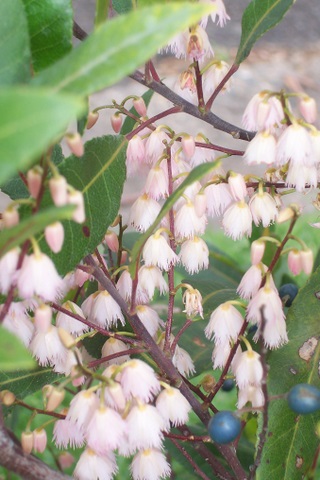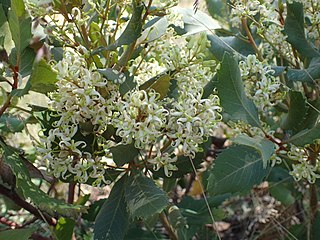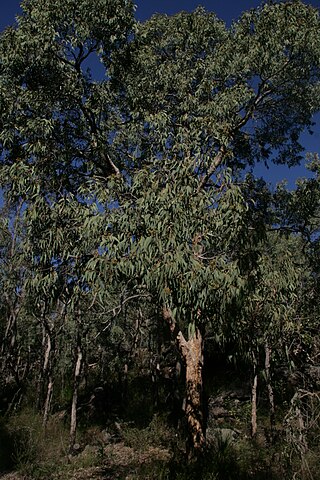
Alphitonia is a genus of arborescent flowering plants comprising about 20 species, constituting part of the buckthorn family (Rhamnaceae). They occur in tropical regions of Southeast Asia, Oceania and Polynesia. These are large trees or shrubs. In Australia, they are often called "ash trees" or "sarsaparilla trees". This is rather misleading however; among the flowering plants, Alphitonia is not closely related to the true ash trees, and barely at all to the monocot sarsaparilla vines (Smilax).

Colubrina is a genus of about 30 species of flowering plants in the family Rhamnaceae, native to warm temperate to tropical regions of Africa, the Americas, southern Asia, northern Australia, and the Indian Ocean islands.

Elaeocarpus reticulatus, commonly known as blueberry ash, ash quandong, blue olive berry, fairy petticoats, fringe tree, koda, lily of the valley tree and scrub ash, is species of flowering plant in the family Elaeocarpaceae, and is endemic to eastern Australia. It is a shrub or small tree with oblong to elliptic leaves, racemes of white or pink flowers and blue, oval to spherical fruit.

Mallee are trees or shrubs, mainly certain species of eucalypts, which grow with multiple stems springing from an underground lignotuber, usually to a height of no more than 10 m (33 ft). The term is widely used for trees with this growth habit across southern Australia, in the states of Western Australia, South Australia, New South Wales and Victoria, and has given rise to other uses of the term, including the ecosystems where such trees predominate, specific geographic areas within some of the states and as part of various species' names.

Eucalyptus crenulata, commonly known as Buxton gum, silver gum or Victorian silver gum, is a rare species of medium-sized tree that is found only in the wild in a small area in Victoria but is widely planted. It has rough, compacted bark on the trunk, sessile, egg-shaped to heart-shaped leaves arranged in opposite pairs, flower buds covered with a white, powdery bloom, white flowers and cup-shaped fruit.

Angophora hispida grows as a mallee, or as a tree to about 7 m (25 ft) in height. A. hispida's small size, especially when compared to its Angophora and Eucalyptus relatives, leads to it being known by the common name dwarf apple. It is native to a relatively small patch of central New South Wales – from just south of Sydney up to the Gosford area. The plant's leaves are sessile (stalk-less) and hug the stem with heart-shaped bases. Its previous name – A. cordifolia – referred to these cordate leaves. Another distinctive feature are the red bristly hairs that cover the branchlets, flower bases and new growth. This leads to the specific epithet hispida.

Dianella caerulea, commonly known as the blue flax-lily, blueberry lily, or paroo lily, is a perennial herb of the family Asphodelaceae, subfamily Hemerocallidoideae, found across the eastern states of Australia and Tasmania. It is a hardy plant, growing to a height and width of around 1 meter with grass-like strappy leaves. Blue flowers in spring and summer are followed by indigo-coloured berries. It adapts readily to cultivation and is commonly seen in Australian gardens and amenities plantings.

Bursaria spinosa is a small tree or shrub in the family Pittosporaceae. The species occurs mainly in the eastern and southern half of Australia and not in Western Australia or the Northern Territory. Reaching 10 m (35 ft) high, it bears fragrant white flowers at any time of year but particularly in summer. A common understorey shrub of eucalyptus woodland, it colonises disturbed areas and fallow farmland. It is an important food plant for several species of butterflies and moths, particularly those of the genus Paralucia, and native bees.

Lambertia formosa, commonly known as mountain devil, is a shrub of the family Proteaceae, endemic to New South Wales, Australia. First described in 1798 by English botanist James Edward Smith, it is the type species of the small genus Lambertia. It is generally found in heathland or open forest, growing in sandstone-based soils. It grows as a multistemmed shrub to around 2 m (7 ft) with a woody base known as a lignotuber, from which it regrows after bushfire. It has stiff narrow leaves, and the pink to red flowerheads, made up of seven individual tubular flowers, generally appear in spring and summer. It gains its common name from the horned woody follicles, which were used to make small devil-figures.

Kunzea ambigua, commonly known as white kunzea, poverty bush or tick bush, is a plant in the myrtle family, Myrtaceae and is found mainly on sandstone soils in eastern Australia. Growing up to 5 m (16 ft) high and wide, it bears small white flowers in spring. Used in native gardening, it attracts native insects. It is also used in amenities planting and sand dune stabilization.

Glochidion ferdinandi, with common names that include cheese tree, is a species of small to medium–sized trees, constituting part of the plant family Phyllanthaceae. They grow naturally across eastern Australia, from south–eastern New South Wales northwards to northern and inland Queensland, in rainforests and humid eucalypt forests. Frugivorous birds such as pigeons, figbirds and parrots consume its fruit. The tree roots and branches are toxic to dogs, causing liver failure and death.

Angophora floribunda, commonly known as the rough-barked apple, is a common woodland and forest tree of the family Myrtaceae native to Eastern Australia. Reaching 30 m (100 ft) high, it is a large tree with fibrous bark and cream-white flowers that appear over the Austral summer. It grows on alluvial soils on floodplains and along watercourses. Much of the land it grew on has been cleared for agriculture.

Lomatia fraseri, commonly known as tree lomatia, forest lomatia or silky lomatia is a plant of the family Proteaceae native to eastern Australia. It grows as a shrub or small tree, reaching 8–11 metres (26–36 ft) high, with highly variable leaves. The cream to white inflorescences appear over summer. It is found in rainforest margins, gullies and heathland in mountainous regions of Victoria and New South Wales. It regenerates from fire by regrowing from a lignotuber.

Dampiera purpurea, commonly known as the mountain- or purple dampiera, is a subshrub in the family Goodeniaceae native to Victoria, New South Wales and Queensland in eastern Australia. Its blue-purple flowers appear in spring and early summer, and it is pollinated by insects such as butterflies and bees. Adapting readily to cultivation, Dampiera purpurea is grown as a garden plant in Australia.

Telopea oreades, commonly known as the Gippsland-, mountain- or Victorian waratah, is a large shrub or small tree in the family Proteaceae. Native to southeastern Australia, it is found in wet sclerophyll forest and rainforest on rich acidic soils high in organic matter. No subspecies are recognised, though a northern isolated population hybridises extensively with the Braidwood waratah (T. mongaensis). Reaching a height of up to 19 metres, T. oreades grows with a single trunk and erect habit. It has dark green leaves with prominent veins that are 11–28 centimetres (4.3–11 in) long and 1.5–6 cm (0.6–2.4 in) wide. The red flower heads, known as inflorescences, appear in late spring. Each is composed of up to 60 individual flowers.

Corymbia eximia, commonly known as yellow bloodwood, is a bloodwood native to New South Wales. It occurs around the Sydney Basin often in high rainfall areas on shallow sandstone soils on plateaux or escarpments, in fire prone areas. Growing as a gnarled tree to 20 m (66 ft), it is recognisable by its distinctive yellow-brown tessellated bark. The greyish green leaves are thick and veiny, and lanceolate spear- or sickle-shaped. The cream flowerheads grow in panicles in groups of seven and appear in spring. Known for many years as Eucalyptus eximia, the yellow bloodwood was transferred into the new genus Corymbia in 1995 when it was erected by Ken Hill and Lawrie Johnson. It is still seen under the earlier name in some works.

Xylomelum pyriforme, commonly known as the woody pear, is a species of plant in the family Proteaceae native to eastern Australia. It grows as a large shrub or small tree to five metres high.
Anthony Russell Bean is an Australian botanist who works at the Queensland Herbarium and Brisbane Botanic Gardens, Mount Coot-tha. Since 1982, he has led the Eucalyptus Study Group of the Society for Growing Australian Plants.

Alphitonia petriei, commonly known as the white ash, is a rainforest tree in the family Rhamnaceae from eastern and northern Australia. Other common names include red ash, white-leaf, pink almond and pink ash. It was originally collected from the Johnstone River in October 1917 by H. Ladbrook, but the designated type for this species was collected by Cyril Tenison (C.T.) White in March 1922 from the Barron River near Kuranda. It was described and named in 1925 by K.W. Braid and White who assigned the species epithet petriei in honour of W.R. Petrie, who alerted them to its distinctness.

Alphitonia whitei is a species of flowering tree in the family Rhamnaceae, that is endemic to Queensland in Australia. It is locally known as red ash, red almond or sarsaparilla. When twigs or leaves are broken, a sarsaparilla or liniment type scent is emitted.



















